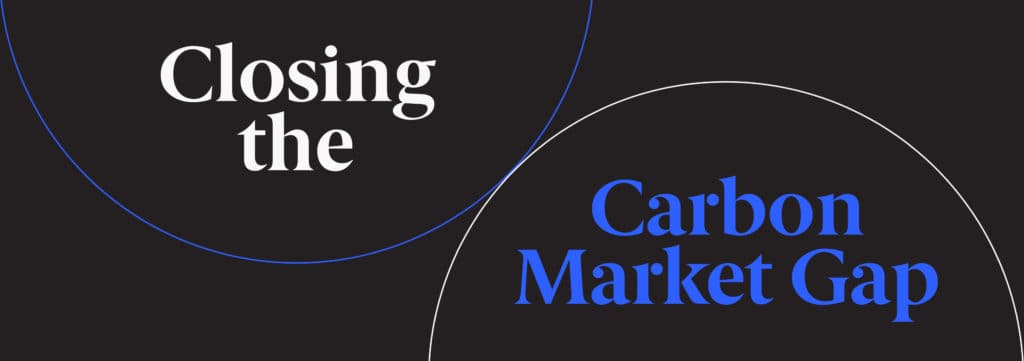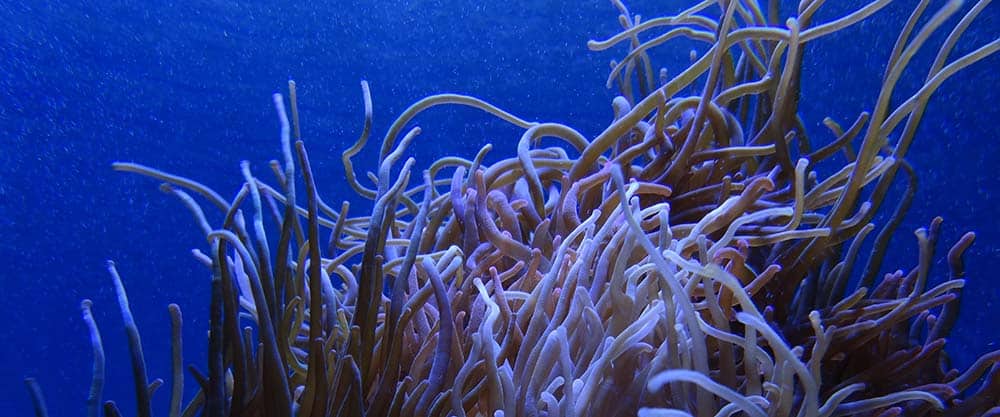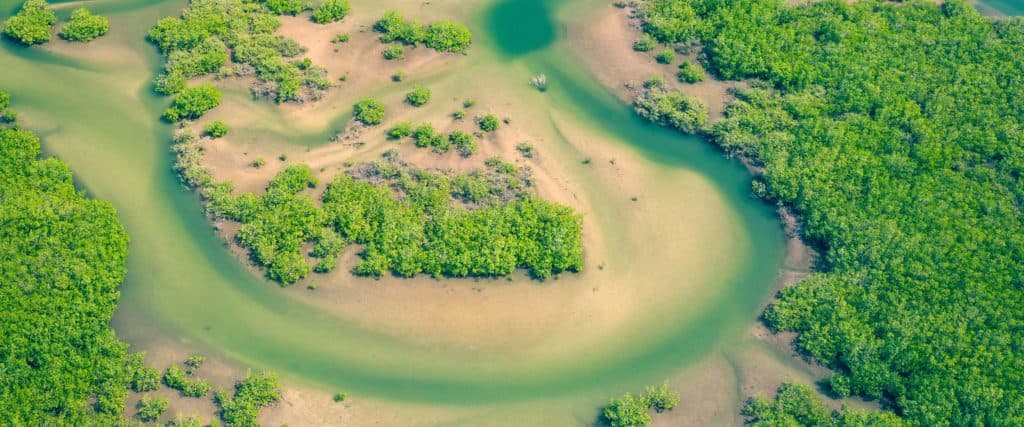What Is Blue Carbon?


WHAT IS THE CARBON MARKET?
Climate Services Director Nicole Sullivan joined Joe Batir of the Energy Transition Solutions podcast to take a deep dive into how companies can leverage carbon offsets to meet their sustainability goals. Read the summary or listen now.
Coastal blue carbon habitats sequester carbon at a rate 10 times greater than terrestrial forests.
Blue carbon ecosystems play an essential role in mitigating climate change and improving human well-being. Coastal wetlands, such as mangrove forests, seagrass beds, and salt marshes, are blue carbon ecosystems that help mitigate global warming in part due to their ability to store more carbon per acre than a tropical rainforest. Expanding international commitments to fight climate change have increased the awareness of coastal blue carbon. In 2021, the National Oceanic and Atmospheric Administration (NOAA) announced the launch of the NOAA Blue Carbon Inventory Project, with the goal of assisting partner countries in incorporating blue carbon ecosystems into their inventories of emissions sources and sinks, as well as their plans to reduce their carbon footprints and adapt to climate change. But what is blue carbon, and why is it so significant to climate policy?
What Is Blue Carbon?
Blue carbon is a term that describes carbon stored specifically in coastal and marine ecosystems. Protecting and expanding these stores of carbon can help slow climate change by assisting in the removal and long-term storage of greenhouse gasses (GHGs) from the atmosphere. Coastal areas with blue carbon stores are known as blue carbon ecosystems. Blue carbon ecosystems have a small global footprint in total area, but their deep, water-logged soils can store far more carbon per acre than terrestrial forests, making them an essential element of a comprehensive plan to stop and reverse the impacts of climate change.
Coastal blue carbon habitats are considered natural “carbon sinks” because they absorb more carbon than they release. They also keep carbon stored for longer periods of time when areas are protected from development or damage. When sampled, carbon found in coastal soils is frequently thousands of years old, demonstrating a high level of permanence.
Blue carbon ecosystems are found on every continent except Antarctica, covering approximately 49 million hectares worldwide. Healthy blue carbon ecosystems also provide food security and livelihoods to coastal communities. They naturally filter water flowing into our oceans and reef systems and protect coastlines from erosion and storm surges.

Blue carbon ecosystems, including mangroves, algae, tidal and salt marshes, and seagrasses, are highly productive coastal ecosystems critical for storing carbon within plants and sediments in the water bodies. Scientific studies show that these areas can sequester carbon at a rate 10 times greater than terrestrial forests, which are sometimes called “green carbon,” and are a popular source of nature-based carbon offset credits.
According to Professor Carlos Duarte, a worldwide leader in multiple branches of biological oceanography and marine ecology, the most significant colors relating to the role of ecosystems in the climate crisis are blue and green. “Green carbon reflects the carbon sequestered by land ecosystems and incorporates carbon in soils and within biomass such as trees in forests,” Duarte explained. “Blue carbon, by contrast, describes the carbon sequestered in the ocean, the definition of which originally focused on mangroves, salt marshes and seagrasses, but now also includes seaweed, sediments more broadly, and even carbon sequestered by whales.”
Many environmental scientists have supported the notion that blue carbon has no adverse impacts or leakages and provides additional co-benefits such as expanded fishery resources and erosion protection. When disturbed, however, the massive carbon stocks locked in coastal soils may be released. The loss of approximately half of the coastal areas worldwide has contributed to GHG emissions and climate change.
Looking for blue carbon credits? We can help.
CarbonBetter helps clients acquire and retire blue carbon offsets that match preferences for vintage, geographies, additionality, and technologies. Reach out today to get started.
Learn MoreTypes of Blue Carbon
Blue carbon habitats are among the most biologically diverse environments on the planet. They have been described as “the most productive ecosystems on land,” with a variety of lifeforms and high production rates. Some blue carbon habitats produce so many co-benefits, like food security through maintaining healthy fish stocks, that they can sustain entire economies.

Mangroves
Mangroves, which are evergreen forests or shrub lands that occur in both tropical and subtropical estuaries and shorelines, are among the most productive ecosystems on the planet. They are crucial in preserving biodiversity, protecting coastal areas from storms and flooding, and providing livelihoods for communities.
Mangroves help to mitigate the effects of climate change by acting as carbon sinks, or storing carbon dioxide emitted by the combustion of fossil fuels such as coal or oil. As mangroves grow, they absorb carbon from the atmosphere and use it to develop their leaves, roots, and branches. When leaves and older trees die, they settle to the seafloor with their stored carbon, creating a carbon sink within the soil.
“Green carbon reflects the carbon sequestered by land ecosystems and incorporates carbon in soils and within biomass such as trees in forests. Blue carbon, by contrast, describes the carbon sequestered in the ocean, the definition of which originally focused on mangroves, salt marshes and seagrasses, but now also includes seaweed, sediments more broadly, and even carbon sequestered by whales.”
Professor Carlos Duarte, Marine Ecologist

Closing the Carbon Market Gap
According to Bank of America, carbon offset supply may need to grow as much as 50x by 2050 to achieve net-zero emissions. Watch the replay as three experts discuss efforts to close this gap and the challenges in developing projects and issuing credits at scale.

Carbon offset registries Overview
Carbon offsets are a tool for businesses and individuals that have made a commitment to reach net-zero emissions or are working to reduce their emissions. Learn more about the state of the carbon market, how credits are issued, and other considerations.

Seagrass, Seaweed, and Kelp
Seagrass and seaweed create blue carbon habitats often found in coastal areas. Seagrass is a kind of marine grass that grows in shallow water and floats on the surface. It absorbs carbon about 35 times faster than trees and absorbs 10% of the ocean's carbon annually.
While seagrass may look like seaweed, they are distinctly different; seaweed is a type of algae that lives in saltwater and can photosynthesize under the sun. Kelp is a seaweed that grows on rocks at low tide levels. Unlike seaweed, seagrasses are considered vascular plants and have root systems with stems and leaves.
When they die, all three species form large mats on the ocean floor; therefore, they are valuable for carbon sequestration. Most carbon sequestered is stored in the sediment.

Algae and Phytoplankton
Algae and phytoplankton are also common types of blue carbon habitats. Algae are single-celled plants that use photosynthesis to create energy from sunlight during the day. Phytoplankton are microscopic plants that spend most of their lives in the water column, feeding on other species at night or during low-light conditions.
Phytoplankton is photosynthetic, which means it uses carbon from the atmosphere to grow. However, when the population size is unchecked, the benefits of carbon sequestration can turn negative.

Salt Marshes and Estuaries
Salt marshes and estuaries are critical types of blue carbon habitats. They are home to many plant and animal species and various creatures that live on the seabed. Because salt marshes and estuaries are often surrounded by water, they are ideal sources of plankton which draws in biodiversity.
Salt marshes and estuaries are critical and highly effective carbon sinks, with research showing stored carbon dating back 2,500 years. As these wetland plants grow and photosynthesize, they absorb carbon dioxide from the atmosphere and convert it into organic matter, as mangroves and seagrass do.
Benefits and Challenges of Blue Carbon
Blue carbon ecosystems are essential to many coastal communities because of their valuable co-benefits. Aside from their carbon storage, blue carbon ecosystems provide jobs and income to local economies, improve water quality, support healthy fisheries, and provide coastal protection. These ecosystems offer vital nursery habitats, breeding grounds for fisheries, and various recreational opportunities.
Mangroves, for example, act as natural barriers, stabilizing shorelines and reducing wave energy, lowering the risk of flooding to coastal communities from storm surges and sea-level rise. Seagrass meadows trap suspended sediments in their roots, reducing erosion and increasing light attenuation. Coastal wetlands absorb pollutants, preserving water quality and preventing eutrophication.
Coastal habitats are critical for carbon capture, but their destruction poses a significant risk. When these habitats are damaged or destroyed, they lose more than just their carbon sequestration capacity. Carbon stored in habitats can be released into the atmosphere, contributing to higher levels of greenhouse gasses.
Unfortunately, coastal habitats are rapidly disappearing worldwide, primarily because of coastal development for housing, ports, and commercial facilities. The development of these areas leads to the loss of these natural resources that contribute to climate change mitigation efforts by storing vast amounts of carbon. Blue carbon offset projects work to protect and restore coastal habitats to ensure long-term carbon storage goals are met.
Conclusion
There is no silver bullet for reversing climate change, but one thing that can help fight global warming is improving our ocean ecosystems' resilience and supporting blue carbon ecosystems for the long-term sequestration of carbon. Preserving blue carbon coastal habitats safeguards healthy coastal environments, which provides many other co-benefits, such as recreational opportunities, storm protection, and nursery habitat for commercial and recreational fisheries.
CarbonBetter clients often seek out blue carbon credits as part of a comprehensive sustainability strategy due to the importance of preserving blue carbon habitats worldwide. The CarbonBetter team actively participates in the carbon markets and provides expert guidance to organizations seeking to measure, reduce, offset, and report carbon emissions, waste, and water impacts. Contact us to explore options for beginning or accelerating your sustainability journey.